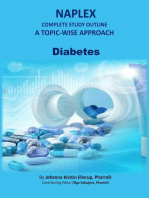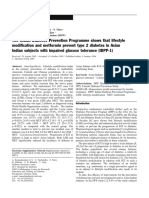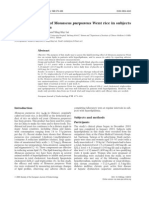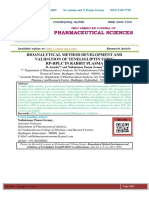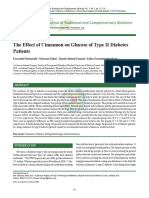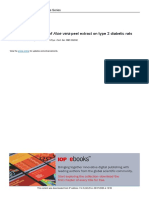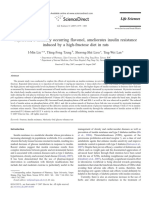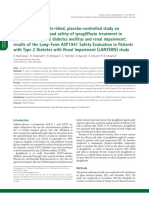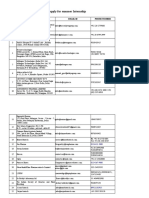Anjana Hypoglycemic Effect of Bitter Melon Compared With Metformin in Newly
Anjana Hypoglycemic Effect of Bitter Melon Compared With Metformin in Newly
Uploaded by
pepe_onetCopyright:
Available Formats
Anjana Hypoglycemic Effect of Bitter Melon Compared With Metformin in Newly
Anjana Hypoglycemic Effect of Bitter Melon Compared With Metformin in Newly
Uploaded by
pepe_onetCopyright
Available Formats
Share this document
Did you find this document useful?
Is this content inappropriate?
Copyright:
Available Formats
Anjana Hypoglycemic Effect of Bitter Melon Compared With Metformin in Newly
Anjana Hypoglycemic Effect of Bitter Melon Compared With Metformin in Newly
Uploaded by
pepe_onetCopyright:
Available Formats
Journal of Ethnopharmacology 134 (2011) 422428
Contents lists available at ScienceDirect
Journal of Ethnopharmacology
journal homepage: www.elsevier.com/locate/jethpharm
Hypoglycemic effect of bitter melon compared with metformin in newly diagnosed type 2 diabetes patients
Anjana Fuangchan a,1 , Paveena Sonthisombat a, , Tippawadee Seubnukarn b,2 , Rapeepan Chanouan c,3 , Pontap Chotchaisuwat d,4 , Viruch Sirigulsatien e,5 , Kornkanok Ingkaninan f,6 , Pinyupa Plianbangchang a,7 , Stuart T. Haines g
a
Department of Pharmacy Practice, Faculty of Pharmaceutical Sciences, Naresuan University, Muang, Phitsanulok 65000, Thailand Dansai Crown Prince Hospital, Dansai, Leuy 42120, Thailand c Chiangkan Hospital, Chiangkan, Leuy 42110, Thailand d Nakhonthai Crown Prince Hospital, Nakhonthai, Phitsanulok 65120, Thailand e Diabetes Clinic, Buddhachinaraj Hospital, Muang, Phitsanulok 65000, Thailand f Department of Pharmaceutical Chemistry and Pharmacognosy, Faculty of Pharmaceutical Sciences and Center of Excellence for Innovation in Chemistry, Naresuan University, Phitsanulok 65000, Thailand g University of Maryland, School of Pharmacy, Baltimore, MD 21201, USA
b
a r t i c l e
i n f o
a b s t r a c t
Ethnopharmacological relevance: Bitter melon (Momordica charantia L.) has been widely used as an traditional medicine treatment for diabetic patients in Asia. In vitro and animal studies suggested its hypoglycemic activity, but limited human studies are available to support its use. Aim of study: This study was conducted to assess the efcacy and safety of three doses of bitter melon compared with metformin. Materials and methods: This is a 4-week, multicenter, randomized, double-blind, active-control trial. Patients were randomized into 4 groups to receive bitter melon 500 mg/day, 1000 mg/day, and 2000 mg/day or metformin 1000 mg/day. All patients were followed for 4 weeks. Results: There was a signicant decline in fructosamine at week 4 of the metformin group (16.8; 95% CI, 31.2, 2.4 mol/L) and the bitter melon 2000 mg/day group (10.2; 95% CI, 19.1, 1.3 mol/L). Bitter melon 500 and 1000 mg/day did not signicantly decrease fructosamine levels (3.5; 95% CI 11.7, 4.6 and 10.3; 95% CI 22.7, 2.2 mol/L, respectively). Conclusions: Bitter melon had a modest hypoglycemic effect and signicantly reduced fructosamine levels from baseline among patients with type 2 diabetes who received 2000 mg/day. However, the hypoglycemic effect of bitter melon was less than metformin 1000 mg/day. 2011 Elsevier Ireland Ltd. All rights reserved.
Article history: Received 11 September 2010 Received in revised form 4 December 2010 Accepted 29 December 2010 Available online 4 January 2011 Keywords: Momordica charantia Bitter melon Hypoglycemic effect Diabetes mellitus
1. Introduction Bitter melon (Momordica charantia L., Cucurbitaceae) grows in Thailand and many countries of Asia. Its fruit, fruit juice or dried powder preparation, has been widely used as traditional medicine
Corresponding author. Tel.: +66 5 596 3674; fax: +66 5 596 3831. E-mail addresses: anjanaf@nu.ac.th (A. Fuangchan), paveenas@nu.ac.th (P. Sonthisombat), kornkanoki@nu.ac.th (K. Ingkaninan), pinyupa@nu.ac.th (P. Plianbangchang), shaines@rx.umaryland.edu (S.T. Haines). 1 Tel.: +66 5 961838; fax: +66 5 596 3831; mobile: +66 6 680 9747. 2 Tel.: +66 4 289 1314/1276; fax: +66 4 289 1276. 3 Tel.: +66 4 282 1101; fax: +66 4 282 1101. 4 Tel.: +66 5 538 8995; fax: +66 5 538 9015. 5 Tel.: +66 5 521 9844. 6 Tel.: +66 5 596 1860; fax: +66 5 596 3831. 7 Tel.: +66 5 596 1800; fax: +66 5 596 3831. 0378-8741/$ see front matter 2011 Elsevier Ireland Ltd. All rights reserved. doi:10.1016/j.jep.2010.12.045
for lowering blood glucose levels. Experimental animal studies indicated that bitter melon fruits exhibited hypoglycemic effects (Akhtar et al., 1981; Karunanayake et al., 1984; Day et al., 1990; Karunanayake et al., 1990; Srivastava, 1993; Cakici et al., 1994; Sarkar et al., 1996; Vikrant et al., 2001; Rathi et al., 2002a,b; Kar et al., 2003; Virdi et al., 2003; Ahmed et al., 2004; Sathishsekar and Subramanian, 2005; Abd El Sattar El Batran et al., 2006; Yibchok-Anun et al., 2006). Further, a systemic review of various herbal products widely used for the treatment of type 2 diabetes conrmed the potential blood glucose lowering effects of bitter melon (Yeh et al., 2003). The exact mechanism of action by which bitter melon exerts its hypoglycemic effect is unknown, but several mechanisms have been proposed. Bitter melon may possess insulin-like properties (Khanna et al., 1981), increase insulin secretion (Welihinda et al., 1982; Yibchok-Anun et al., 2006), preserved pancreatic islet cells (Ahmed et al., 1998), increase tissue glucose uptake (Welihinda and Karunanayake, 1986; Cummings et al.,
A. Fuangchan et al. / Journal of Ethnopharmacology 134 (2011) 422428
423
2004), decrease glucose absorption (Shetty et al., 2005), increase liver and muscle glycogen storage (Welihinda and Karunanayake, 1986; Sarkar et al., 1996), depress hepatic gluconeogenesis (Shibib et al., 1993), and improve the activity of key enzymes of the glycolytic pathway (Rathi et al., 2002a). To date, there were clinical studies to determine the efcacy of bitter melon in patients with type 2 diabetes. However, these studies were often not randomized, lacked a control group, short in duration, inadequately explained statistical methods or patient recruitment criteria, and did not systematically monitor or report adverse events (Leatherdale et al., 1981; Welihinda et al., 1986; Srivastava, 1993; Ahmad et al., 1999; Tongia et al., 2004). Thus, additional evidence is needed to support the efcacy and safety of bitter melon for the treatment of type 2 diabetes mellitus. This study aimed to investigate hypoglycemic effect of various dosages of bitter melon compared with metformin and to determine the minimum effective dose of bitter melon. 2. Experimental 2.1. Bitter melon preparation Bitter melon was grown at, Phitsanulok. The voucher specimens were kept at the PBM Herbarium, Mahidol University, Thailand. Unripe bitter melon fruits 35 in. long were collected and the seeds were removed. Fruit pulps were dried by hot air oven at 60 C for 24 h. Dried fruit pulps were tested for microbial contamination by Faculty of Medical Sciences, Naresuan University, and heavy metal and insecticide contamination by Regional Medical Sciences Center, Phitsanulok. Dried fruit pulps which passed all tests were powdered. Each capsule contained 500 mg of dried powder of the fruit pulp, containing 0.040.05% (w/w) of charantin. The charantin level was determined by Faculty of Pharmaceutical Sciences, Mahidol University, Thailand, using HPLC method (Pitipanapong et al., 2007). 2.2. Clinical trial The protocol was approved by the Ethics Committee for Human Research of Naresuan University (50 03 01 0010), the Institute of Thai Traditional Medicine, Ministry of Public Health (No. 62), and Buddhachinaraj Hospital, Thailand. 2.2.1. Study design This was a 4-week, multicenter, randomized, double-blind, active-control trial in 4 paralleled treatment groups. Patients were recruited by four hospitals including Dansai Crown Prince Hospital, Chiangkhan Hospital, Nakhonthai Crown Prince Hospital and Buddhachinaraj Hospital, Thailand from September 2007 to March 2009. 2.2.2. Inclusion and exclusion criteria Eligible patients were those between 35 and 70 years of age, newly diagnosis with type 2 diabetes based on a fasting plasma glucose (FPG) 126 mg/dL or 2-h postprandial glucose levels during 75-g oral glucose tolerance-test (OGTT) 200 mg/dL (American Diabetes Association, 2006), and whose FPG levels did not exceed 180 mg/dL. Patients were excluded if any of the following was present: serum creatinine higher than 1.8 mg/dL; serum alanine aminotransferase (ALT), aspartate aminotransferase (AST), total bilirubin or alkaline phosphatase higher than 2.5 times of the upper normal range; anemia (hemogloblin <11 g/dL for male, <10 g/dL for female); severe angina; moderate-severe heart failure with left ventricular hypertrophy (LVH); pregnant and lactating women;
sulfonylureas, metformin, thiazolidinediones, glitinides, alphaglucosidase inhibitors or insulin use prior to study enrollment; participation in another clinical trial within 30 days of screening; long-term diabetic complications such as diabetic retinopathy, diabetic neuropathy which need therapy (painful peripheral neuropathy, systemic orthostatic hypotension, urinary retention, foot ulcers or gastric stasis); a body mass index (BMI) less than 18 or greater than 38; or a body weight variation more than 10% during the screening period. 2.2.3. Study protocol After receiving oral and written explanation of the study, each patient provided written informed consent before enrolling in the study. All patients were counseled regarding dietary and lifestyle modication. At the rst visit, patients were screened for eligibility and received a placebo during a 2-week run-in period. After run-in period, eligible patients were randomized to one of the four arms: 500 mg/day, 1000 mg/day, 2000 mg/day of bitter melon or 1000 mg/day of metformin by block randomization. Doses of bitter melon based on available bitter melon product in Thailand and our retrospective study at Dansai Hospital, Thailand which having experience in bitter melon using for treatment type 2 diabetes (Fuangchan et al., 2009). Patients received bitter melon or metformin for 4 weeks. Bitter melon and metformin were supplied as 500 mg capsules and 500 mg tablets, respectively. Each patient received 2 capsules before meals and 2 tablets after meals twice daily. Roasted rice powder was used as placebo of bitter melon and lactose was used as placebo of metformin. To maintain blinding, double dummy technique was used. Patients were scheduled to visit the investigational site at week 1 and week 4 after randomization. In the metformin group, patients started with 500 mg/day for one week and then the dose was increased to 1000 mg/day until end of study. Drug compliance was determined by pill counting and patients interviews at each visit. 2.2.4. Outcome measure The primary efcacy outcome was the mean change in fructosamine from baseline to endpoint. Fructosamine is a test to evaluate glycemic control over the previous 23 weeks and assess more recent changes in glycemic status as compare to HbA1C. It was measured by Calorimetric Test on Roche/Hitachi 717 analyzer. This analysis was based on the ability of ketoamines to reduce nitroblue tetrazolium in alkaline medium. The reaction rate was measured by photometry at 546 nm. The secondary outcomes were mean change in fasting plasma glucose and 2-h plasma glucose after a 75-g glucose load from baseline to endpoint. Safety was monitored by assessing patient reported symptoms, changes in ndings on physical examination, vital signs, laboratory tests (complete blood count, blood urea nitrogen, serum creatinine, and liver function test), and reports of hypoglycemia during the study period. Hypoglycemia was dened by symptoms associated with hypoglycemia or serum glucose level less than 60 mg/dL. Severe hypoglycemia was dened as having symptoms that required assistance and associated with either a glucose level less than 60 mg/dL or improved after receiving oral carbohydrate or intravenous glucose. Patients recorded all adverse events in their diary. If they had any abnormal events, they were instructed to return to the clinic before the next appointment. 2.3. Statistical analysis Intention-to-treat (ITT) was used to evaluate the efcacy of treatments. ITT sample was dened as patients who received at least one dose of study medication and had at least one postbaseline measurement of fructosamine. Last observation carried forward (LOCF) method was used for missing values. An interim
424
A. Fuangchan et al. / Journal of Ethnopharmacology 134 (2011) 422428
Fig. 1. Subject enrollment and follow up.
analysis was performed. If the interim analysis demonstrated differences between groups, the study would have been terminated. Normal distribution was tested by box plot and test of normality. Data were checked for the presence of outliers by using box plot. Data points that were greater than 3.0 interquartile ranges above the 75th percentile or below the 25th percentile were dened as outliers and excluded. The differences of mean reduction in fructosamine, fasting plasma glucose, and 2-h plasma glucose after 75-g glucose loaded between bitter melon groups and the metformin group were compared by ANOVA. All statistical tests were performed at the two-sided p less than 0.05 level. 3. Results 3.1. Patient characteristics The total of 143 patients were enrolled into the study; 129 patients were randomized to the either metformin (n = 33), bitter melon 500 mg/day (n = 33), bitter melon 1000 mg/day (n = 32), or bitter melon 2000 mg/day (n = 31). Eight patients had protocol violations including age less than 35-year old (3 patients), mild anemia (2 patients), pre-diabetes (1 patient), and liver enzymes over 2.5 times of upper normal range (2 patients). A patient in the bitter melon 2000 mg/day group was lost follow up. Patient disposiTable 1 Baseline of patient characteristics. Metformin 1000 mg/day N Sex (%) Female Male Age (years) Weight (kg) Body mass index (kg/m2 ) Co-morbid diseases Hypertension Dyslipidemia Thyroid diseases Asthma FPG at screening 33 24 (72.7%) 9 (27.3%) 52.5 9.2 59.8 10.7 24.4 3.1 15 (45.4%) 8 (24.2%) 3 (9.1%) 3 (9.1%) 1 (3.0%) 144.0 17.8 Bitter melon 500 mg/day 33 25 (75.8%) 8 (24.2%) 52.2 8.3 60.9 9.2 25.0 3.4 11 (33.3%) 6 (18.2%) 4 (12.1%) 0 1 (3.0%) 137.3 17.8
tion is diagrammed in Fig. 1. Two patients were excluded because of outlier problem. Most of eligible subjects (93 patients, 73.2%) were female. Mean ages and body mass index (BMI) were 51.8 9.3 years and 25.1 3.4 kg/m2 , respectively. Co-morbid diseases were hypertension, dyslipidemia, asthma and thyroid diseases. All three patients who had thyroid disease were in metformin group. Two of them were well controlled without medication and one of them was well controlled by thyroxine. Baseline characteristics of patients in each treatment group were similar (Tables 1 and 2). The rate of treatment compliance was the same in all four groups (99%). 3.2. Glycemic control 3.2.1. Change in fructosamine At week 4, a signicant reduction in mean fructosamine levels from baseline were observed in patients who received metformin 1000 mg/day and bitter melon 2000 mg/day (16.8 mol/L; 95% CI, 31.2 to 2.4 and 10.2 mol/L; 95% CI, 19.1 to 1.3, respectively). In contrast, the 500 and 1000 mg/day of bitter melon groups did not experience a statistically signicant reduction in fructosamine levels from baseline (by 3.5 mol/L; 95% CI, 11.7 to 4.6 and 10.3 mol/L; 95% CI, 22.7 to 2.2 mol/L, respectively). The comparison of the mean change of fructosamine levels from baseline between treatments was not signicantly different (p = 0.41) (Table 3).
p-Value 1000 mg/day 32 26 (81.2%) 6 (18.8%) 50.6 10.7 63.7 10.5 25.6 3.9 10 (31.2%) 7 (21.9%) 3 (9.4%) 0 0 144.6 13.3 2000 mg/day 31 20 (64.5%) 11 (35.5%) 52.0 9.1 63.8 9.4 25.4 3.0 12 (38.7%) 7 (22.6%) 5 (16.1%) 0 0 147.2 14.1 0.62 0.85 0.27 0.47 0.30
0.10
Note: data are n (%) or means SD. p > 0.05 indicated no difference between groups.
A. Fuangchan et al. / Journal of Ethnopharmacology 134 (2011) 422428 Table 2 Characteristics of patients after cutting outliers. Metformin 1000 mg/day N Sex (%) Female Male Age (years) Weight (kg) Body mass index (kg/m2 ) Co-morbid diseases Hypertension Dyslipidemia Thyroid diseases Asthma FPG at screening 33 24 (72.7%) 9 (27.3%) 52.5 9.2 59.8 10.7 24.4 3.1 15 (45.4%) 8 (24.2%) 3 (9.1%) 3 (9.1%) 1 (3.0%) 144.0 17.8 Bitter melon 500 mg/day 32 24 (75.0%) 8 (25.0%) 52.3 8.3 60.8 9.3 24.9 3.4 11 (34.4%) 6 (18.8%) 4 (12.5%) 0 1 (3.1%) 137.4 18.1 1000 mg/day 32 26 (81.3%) 6 (18.7%) 50.6 10.7 63.7 10.5 25.6 3.9 10 (31.2%) 7 (21.9%) 3 (9.4%) 0 0 144.6 13.3 2000 mg/day 30 19 (63.3%) 11 (34.4%) 52.3 9.1 63.1 8.7 25.1 2.7 12 (40.0%) 7 (23.3%) 5 (16.7%) 0 0 146.9 14.3 0.46 0.82 0.33 0.49 0.77
425
p-Value
0.13
Note: data are n (%) or means SD. p > 0.05 indicated no difference between groups.
3.2.2. Change in fasting plasma glucose Metformin signicantly reduced FPG from baseline to endpoint (by 14.7 mg/dL; 95% CI, 20.3 to 9.4). At the endpoint, bitter melon 500, 1000, and 2000 mg/day did not reduce FPG when compared to the baseline (by 0.88 mg/dL; 95% CI, 6.9 to 8.6, 2.1 mg/dL; 95% CI, 7.4 to 11.5 and 0.1 mg/dL; 95% CI, 8.0 to 3.5, respectively). Metformin was also associated with a signicantly lower FPG compared with bitter melon 500 mg/day and 1000 mg/day (p = 0.02 and p = 0.01, respectively) (Table 3).
3.4. Safety analysis 3.4.1. Adverse events Bitter melon and metformin were well tolerated. No clinically meaningful difference in the overall adverse event rates was observed. There was no serious clinical adverse event. Headache and dizziness was reported in both metformin and bitter melon groups. Increased appetite was reported in the 2000 mg/day of bitter melon group more frequently than the other groups (Table 4). There were 16 episodes of palpitation; 3 episodes in metformin, and 4, 7 and 2 episodes in bitter melon 500, 1000, and 2000 mg/day, respectively. Few of these episodes were associated with hypoglycemia. Moreover, these symptoms did not require any treatment or discontinuation of metformin or bitter melon and resolved with rest. No patient experienced a symptomatic hypoglycemic event or had a documented blood glucose level <60 mg/dL. 3.4.2. Effects to laboratory parameters There was no clinically relevant shift in laboratory variables from baseline in any treatment group (Table 5). One patient who had high baseline AST (73 U/L) and ALT (82 U/L) levels experienced a slight increase in AST (105 U/L) and ALT (102 U/L) without signs and symptoms of hepatitis after taking bitter melon 500 mg/day. This patients abnormal AST and ALT levels returned to normal after discontinuing treatment. 4. Discussion This study was the rst randomized controlled trial to compare hypoglycemic effect of dried powder of bitter melons fruit pulp
3.2.3. Change in 2-h plasma glucose levels after OGTT No signicant change in 2-h plasma glucose levels after OGTT from baseline to endpoint was observed with bitter melon 500 mg/day, 1000 mg/day, or 2000 mg/day (5.34 mg/dL; 95% CI, 22.7 to 12.0, 12.3 mg/dL; 95% CI, 35.7 to 11.1 and 0.43 mg/dL; 95% CI, 22.4 to 21.6, respectively). There was a signicant change in the mean 2-h plasma glucose levels after OGTT patients taking metformin (32.6 mg/dL; 95% CI 49.5, 15.8). However, the comparison of the mean change of 2-h plasma glucose levels after OGTT levels from baseline between treatments was not signicantly different (p = 0.10) (Table 3).
3.3. Doseresponse relationship of bitter melon A doseresponse relationship of bitter melon on indices of glycemic control was not observed. Only bitter melon 2000 mg/day exhibited a statistically signicance change in mean fructosamine levels from baseline.
Table 3 Effect of metformin and bitter melon on fructosamine, fasting plasma glucose, and 2-h plasma glucose after OGTT at week 4. Baseline Fructosamine (mol/L) Metformin 1000 mg/day (n = 33) Bitter melon 500 mg/day (n = 32) Bitter melon 1000 mg/day (n = 31) Bitter melon 2000 mg/day (n = 29) Fasting plasma glucose (mg/dL) Metformin 1000 mg/day (n = 33) Bitter melon 500 mg/day (n = 32) Bitter melon 1000 mg/day (n = 32) Bitter melon 2000 mg/day (n = 30) 2-h plasma glucose after OGTT (mg/dL) Metformin 1000 mg/day (n = 32) Bitter melon 500 mg/day (n = 32) Bitter melon 1000 mg/day (n = 30) Bitter melon 2000 mg/day (n = 28) 308.3 316.2 323.7 326.8 140.0 140.3 139.5 139.9 262.2 272.0 271.2 242.6 68.1 56.9 51.0 52.8 22.6 17.4 16.0 15.8 73.9 44.5 50.4 47.7 Week 1 305.5 315.0 318.7 323.3 133.8 137.1 137.2 135.7 238.8 275.6 262.4 255.5 60.4 55.6 51.3 48.6 21.3 22.4 21.9 19.3 74.8 54.0 58.3 64.2 Week 4 291.5 312.7 313.5 316.6 125.2 140.9 141.6 137.6 230.3 266.6 255.4 242.2 51.9 54.1 54.1 48.1 22.7 29.4 27.4 18.1 67.7 59.6 74.6 59.2 Mean change from baseline (95% CI) 16.8 40.6 (31.2, 2.4) 3.5 22.7 (11.7, 4.6) 10.3 33.9 (22.7, 2.2) 10.2 23.3 (19.1, 1.3) 14.7 15.4 (20.3, 9.4) 0.9 21.4* (6.9, 8.6) 2.1 26.3* (7.4, 11.5) 2.3 15.5 (8.0, 3.5) 32.6 46.8 (49.5, 15.8) 5.3 48.1 (22.7, 12.0) 12.3 62.7 (35.7, 11.1) 0.43 56.7 (22.4, 21.6)
Data are mean values standard deviation; CI, condence interval. * A signicantly mean different from metformin at p < 0.05.
426
A. Fuangchan et al. / Journal of Ethnopharmacology 134 (2011) 422428
Table 4 Adverse events during receiving metformin and bitter melon for 4 weeks. Metformin 1000 mg/day N Central nervous system Dizziness Headache Lethargy Gastrointestinal tract Anorexia Abdominal pain Constipation Diarrhea Gastrointestinal tract Flatulence Heart burn Increased appetite Nausea Respiratory system Upper respiratory tract infection Musculoskeleton system Arthralgia Back pain Numbness Dermatological system Itching Rash Other Palpitation Note: data are number of patients (%). 33 8 (24.2) 6 (18.2) 3 (9.09) 4 (12.1) 2 (6.06) 2 (6.06) 1 (3.03) 4 (12.1) 3 (9.09) 3 (9.09) 4 (12.1) 3 (9.09) 1 (3.03) 5 (15.2) 4 (12.1) 3 (9.09) 1 (3.03) 3 (9.09) Bitter melon 500 mg/day 32 8 (24.2) 5 (15.2) 2 (6.06) 3 (9.09) 1 (3.03) 2 (6.06) 1 (3.03) 3 (9.09) 2 (6.06) 1 (3.03) 2 (6.06) 5 (15.2) 2 (6.06) 1 (3.03) 1 (3.03) 2 (6.06) 3 (9.09) 4 (12.1) 1000 mg/day 32 7 (21.9) 3 (9.38) 1 (3.12) 4 (12.5) 1 (3.12) 3 (9.38) 1 (3.12) 3 (9.38) 4 (12.5) 1 (3.12) 1 (3.12) 5 (15.6) 4 (12.5) 4 (12.5) 4 (12.5) 4 (12.5) 3 (9.38) 7 (21.9) 2000 mg/day 30 3 (9.68) 7 (22.6) 1 (3.22) 0 2 (6.45) 0 2 (6.45) 0 1 (3.22) 6 (19.4) 1 (3.22) 2 (6.45) 3 (9.68) 3 (9.68) 2 (6.45) 2 (6.45) 2 (6.45) 2 (6.45)
with metformin. The results demonstrated signicantly reduction in fructosamine levels from baseline among patients with type 2 diabetes who received metformin and bitter melon 2000 mg/day. However, there were no different in mean reduction of fructosamine levels between any dose of bitter melon and metformin. Unfortunately, a doseresponse relationship for bitter melon was not exhibited. A lowering in fructosamine levels, but not FPG or 2-h OGTT, was observed with bitter melon 2000 mg/day. In contrast, randomized controlled trials of other bitter melon preparations did not show benet in blood glucose level. John and colleagues (John et al., 2003), a 4-week randomized controlled trial, adding tablets of dried powder of bitter melon fruits 6000 mg/day to other oral hypoglycemic drugs in type 2 diabetes mellitus, failed to show lowering in fructosamine levels
when compared with placebo. Whereas, Dans et al. (2007), bitter melon extract (Charantia ) 3 g/day were given to diabetes patients who had suboptimal glycemic control by pharmacologic or diet therapy. At 3 months of follow up, the results did not show a signicant decline in HbA1c or fasting plasma glucose level when compared with placebo, but this study may have been underpowered to detect a clinically important difference in glycemic control. Both studies did not explain the detail of standardization of bitter melon product or describe the existed oral hypoglycemic treatment regimens. In the present study, reductions in FPG and 2-h plasma glucose after OGTT were not observed with bitter melon. This nding is consistent with a recent study where a single dose of freeze dried bitter melon 50 mg/kg and 100 mg/kg given to healthy volunteers
Table 5 Effect of metformin and bitter melon on laboratory parameters at week 4. Metformin 1000 mg/day N AST (U/L) Baseline Week 4 ALT (U/L) Baseline Week 4 BUN (mg%) Baseline Week 4 Scr (mg%) Baseline Week 4 Hb (g/dL) Baseline Week 4 Hct (%) Baseline Week 4 33 31.3 16.0 26.0 13.5 32.6 19.4 25.2 14.6 12.6 2.84 12.0 3.66 0.89 0.24 0.92 0.19 13.6 1.20 13.3 1.13 41.1 3.31 40.3 3.48 Bitter melon 500 mg/day 33 32.5 14.3 29.5 16.3 29.3 14.8 27.8 19.4 13.5 3.44 12.4 3.60 0.92 0.21 0.89 0.20 13.0 1.40 12.9 1.46 39.2 3.68 39.1 4.30 1000 mg/day 32 31.0 18.8 24.6 13.1 28.8 14.7 23.5 13.9 11.9 3.62 12.6 3.76 0.90 0.17 0.90 0.17 12.8 1.30 12.9 1.41 38.7 3.65 39.1 4.07 2000 mg/day 31 31.5 24.3 27.5 24.2 29.0 24.4 27.1 25.5 12.5 3.10 12.5 2.80 0.92 0.21 0.93 0.25 13.6 1.22 13.5 1.20 40.9 3.97 40.8 3.96 0.99 0.67 0.83 0.80 0.94 0.92 0.28 0.91 0.03 0.13 0.02 0.23 p-Value
Data are mean values standard deviation.
A. Fuangchan et al. / Journal of Ethnopharmacology 134 (2011) 422428
427
did not reduce fasting plasma glucose or plasma glucose after OGTT when compare with placebo (Kasbia et al., 2009). However, the results also disagreed with the case series study of Srivastava (1993)where dried bitter melon powder reduced FPG levels by 1148 mg/dL and our previous retrospective study where the mean reduction in FPG levels was 26.7 40.8 mg/dL (Fuangchan et al., 2009). This might due to difference in process to prepare bitter melon product or difference in amount of active ingredient which did not state in above study. In this clinical study, the results showed the signicant effect of bitter melon on fructosamine levels at 2000 mg/day of bitter melon without effect on fasting plasma glucose level and 2 h plasma glucose after OGTT. Given that FPG and 2 h plasma glucose level after OGTT was performed at scheduled visits, it might not represent an change in overall glycemic control like fructosamine or HbA1C . Bitter melon and metformin were well tolerated in our study. There was a low incidence of important gastrointestinal adverse effects with metformin in this study because the dosage of metformin was slowly titrated. However, some patients experienced an increased appetite with 2000 mg/day of bitter melon. Importantly, we would not recommend bitter melon in patients with abnormal liver function or liver diseases because one patient experienced an elevation of liver enzymes from baseline. Our study was performed for only 4 weeks in duration and fructosamine was used to measure the hypoglycemic effects of bitter melon compared with metformin. Given that bitter melon had no apparent effect on FPG or 2-h OGT measurements, it is notable that the 2000 mg dose of bitter melon signicantly decreased fructosamine concentrations. There is no clear explanation for this observation. Extended duration of study and larger patients group, similar to a phase IIIIV clinical trials needed. Further studies should be conducted for at least 3 months duration. HbA1C , a standard glycemic monitoring, should be selected as the primary outcome to show average blood sugar levels over a longer duration and lowering HbA1C relates to reduce diabetic complications (The Diabetes Control and Complications Trial Research Group, 1993; UK Prospective Diabetes Study (UKPDS) Group, 1998). We elected to use a range of bitter melon dosage from 500 to 2000 mg/day based on our previous retrospective study. Only 2000 mg/day of bitter melon showed a benet in glycemic control. Thus, higher doses of at least 2000 mg/day of bitter melon fruit pulps should be used in future studies. 5. Conclusion Dried powder of fruit pulps of bitter melon 2000 mg/day appears to have a modest hypoglycemic effect based on a decrease in fructosamine concentrations. However, its hypoglycemic effect was less than metformin 1000 mg/day. Acknowledgements Financial assistance from Naresuan University is gratefully acknowledged. The authors wish to thanks Mrs. Kamrai Krittasilp, Head of Pharmacy Department, Bangatum Hospital and Associate Professor Dr. Kanchalee Jetiyanon, Faculty of Agriculture, Naresuan University for offering bitter melon culture. Special thanks to Assistance Professor Dr. Supaporn Lamlertthon, Faculty of Medical Sciences, Naresuan University and Associate Professor Weena Jiratchariyakul and Ms. Monraudee Chanchai, Quality Control Herbal Medicine Project, Faculty of Pharmaceutical Sciences, Mahidol University for helping to do quality control of bitter melon production. In addition, we would like to thank all clinical research co-ordinators: Ms. Darin Jungpattanawadee, Head of Pharmacy Department, Dansai Crown Prince Hospital, Ms. Siri-
porn Sangkwan, Pharmacy Department, Chiangkan Hospital and Mrs. Somjit Chotchaisuwatana, Pharmacy Department, Nakhonthai Crown Prince Hospital. The Center of Excellence for Innovation in Chemistry (PERCH-CIC), Commission on Higher Education, Ministry of Education is gratefully acknowledged. References
Abd El Sattar El Batran, S., El-Gengaihi, S.E., El Shabrawy, O.A., 2006. Some toxicological studies of Momordica charantia L. on albino rats in normal and alloxan diabetic rats. Journal of Ethnopharmacology 108, 236242. Ahmad, N., Hassan, M.R., Halder, H., Bennoor, K.S., 1999. Effect of Momordica charantia (Karolla) extracts on fasting and postprandial serum glucose levels in NIDDM patients. Bangladesh Medical Research Council Bulletin 25, 1113. Ahmed, I., Adeghate, E., Cummings, E., Sharma, A.K., Singh, J., 2004. Benecial effects and mechanism of action of Momordica charantia juice in the treatment of streptozotocin-induced diabetes mellitus in rat. Molecular and Cellular Biochemistry 261, 6370. Ahmed, I., Adeghate, E., Sharma, A.K., Pallot, D.J., Singh, J., 1998. Effects of Momordica charantia fruit juice on islet morphology in the pancreas of the streptozotocindiabetic rat. Diabetes Research and Clinical Practice 40, 145151. Akhtar, M.S., Athar, M.A., Yaqub, M., 1981. Effect of Momordica charantia on blood glucose level of normal and alloxan-diabetic rabbits. Planta Medica 42, 205212. American Diabetes Association, 2006. Standards of medical care in diabetes-2006. Diabetes Care 29, S442. Cakici, I., Hurmoglu, C., Tunctan, B., Abacioglu, N., Kanzik, I., Sener, B., 1994. Hypoglycaemic effect of Momordica charantia extracts in normoglycaemic or cyproheptadine-induced hyperglycaemic mice. Journal of Ethnopharmacology 44, 117121. Cummings, E., Hundal, H.S., Wackerhage, H., Hope, M., Belle, M., Adeghate, E., Singh, J., 2004. Momordica charantia fruit juice stimulates glucose and amino acid uptakes in L6 myotubes. Molecular and Cellular Biochemistry 261, 99 104. Dans, A.M., Villarruz, M.V., Jimeno, C.A., Javelosa, M.A., Chua, J., Bautista, R., Velez, G.G., 2007. The effect of Momordica charantia capsule preparation on glycemic control in type 2 diabetes mellitus needs further studies. Journal of Clinical Epidemiology 60, 554559. Day, C., Cartwright, T., Provost, J., Bailey, C.J., 1990. Hypoglycaemic effect of Momordica charantia extracts. Planta Medica 56, 426429. Fuangchan, A., Seubnukarn, T., Jungpattanawadee, D., Sonthisombat, P., Ingkaninan, K., Plianbangchang, P., et al., 2009. Retrospective study on the use of bitter melon for type 2 diabetes at Dansai Crown Prince Hospital, Thailand. Srinagarind Medical Journal 24, 332338. John, A.J., Cherian, R., Subhash, H.S., Cherian, A.M., 2003. Evaluation of the efcacy of bitter gourd (Momordica charantia) as an oral hypoglycemic agenta randomized controlled clinical trial. Indian Journal of Physiology and Pharmacology 47, 363365. Kar, A., Choudhary, B.K., Bandyopadhyay, N.G., 2003. Comparative evaluation of hypoglycaemic activity of some Indian medicinal plants in alloxan diabetic rats. Journal of Ethnopharmacology 84, 105108. Karunanayake, E.H., Jeevathayaparan, S., Tennekoon, K.H., 1990. Effect of Momordica charantia fruit juice on streptozotocin-induced diabetes in rats. Journal of Ethnopharmacology 30, 199204. Karunanayake, E.H., Welihinda, J., Sirimanne, S.R., Sinnadorai, G., 1984. Oral hypoglycaemic activity of some medicinal plants of Sri Lanka. Journal of Ethnopharmacology 11, 223231. Kasbia, G.S., Arnason, J.T., Imbeault, P., 2009. No effect of acute, single dose oral administration of Momordica charantia Linn., on glycemia, energy expenditure and appetite: a pilot study in non-diabetic overweight men. Journal of Ethnopharmacology 126, 127133. Khanna, P., Jain, S.C., Panagariya, A., Dixit, V.P., 1981. Hypoglycemic activity of polypeptide-p from a plant source. Journal of Natural Products 44, 648655. Leatherdale, B.A., Panesar, R.K., Singh, G., Atkins, T.W., Bailey, C.J., Bignell, A.H., 1981. Improvement in glucose tolerance due to Momordica charantia (karela). British Medical Journal 282, 18231824. Pitipanapong, J., Chitprasert, S., Goto, M., Jiratchariyakul, W., Sasaki, M., Shotipruk, A., 2007. New approach for extraction of charantin from Momordica charantia with pressurized liquid extraction. Separation and Purication Technology 52, 416422. Rathi, S.S., Grover, J.K., Vats, V., 2002a. The effect of Momordica charantia and Mucuna pruriens in experimental diabetes and their effect on key metabolic enzymes involved in carbohydrate metabolism. Phytotherapy Research 16, 236243. Rathi, S.S., Grover, J.K., Vikrant, V., Biswas, N.R., 2002b. Prevention of experimental diabetic cataract by Indian Ayurvedic plant extracts. Phytotherapy Research 16, 774777. Sarkar, S., Pranava, M., Marita, R., 1996. Demonstration of the hypoglycemic action of Momordica charantia in a validated animal model of diabetes. Pharmacological Research 33, 14. Sathishsekar, D., Subramanian, S., 2005. Benecial effects of Momordica charantia seeds in the treatment of STZ-induced diabetes in experimental rats. Biological & Pharmaceutical Bulletin 28, 978983. Shetty, A.K., Kumar, G.S., Sambaiah, K., Salimath, P.V., 2005. Effect of bitter gourd (Momordica charantia) on glycaemic status in streptozotocin induced diabetic rats. Plant Foods for Human Nutrition 60, 109112.
428
A. Fuangchan et al. / Journal of Ethnopharmacology 134 (2011) 422428 and hyperinsulinemia in fructose fed rats. Journal of Ethnopharmacology 76, 139143. Virdi, J., Sivakami, S., Shahani, S., Suthar, A.C., Banavalikar, M.M., Biyani, M.K., 2003. Antihyperglycemic effects of three extracts from Momordica charantia. Journal of Ethnopharmacology 88, 107111. Welihinda, J., Arvidson, G., Gylfe, E., Hellman, B., Karlsson, E., 1982. The insulinreleasing activity of the tropical plant Momordica charantia. Acta Biologica et Medica Germanica 41, 12291240. Welihinda, J., Karunanayake, E.H., 1986. Extra-pancreatic effects of Momordica charantia in rats. Journal of Ethnopharmacology 17, 247255. Welihinda, J., Karunanayake, E.H., Sheriff, M.H., Jayasinghe, K.S., 1986. Effect of Momordica charantia on the glucose tolerance in maturity onset diabetes. Journal of Ethnopharmacology 17, 277282. Yeh, G.Y., Eisenberg, D.M., Kaptchuk, T.J., Phillips, R.S., 2003. Systematic review of herbs and dietary supplements for glycemic control in diabetes. Diabetes Care 26, 12771294. Yibchok-Anun, S., Adisakwattana, S., Yao, C.Y., Sangvanich, P., Roengsumran, S., Hsu, W.H., 2006. Slow acting protein extract from fruit pulp of Momordica charantia with insulin secretagogue and insulinomimetic activities. Biological & Pharmaceutical Bulletin 29, 11261131.
Shibib, B.A., Khan, L.A., Rahman, R., 1993. Hypoglycaemic activity of Coccinia indica and Momordica charantia in diabetic rats: depression of the hepatic gluconeogenic enzymes glucose-6-phosphatase and fructose-1,6-bisphosphatase and elevation of both liver and red-cell shunt enzyme glucose-6-phosphate dehydrogenase. Biochemical Journal 292, 267270. Srivastava, Y., 1993. Antidiabetic and adaptogenic properties of Momordica charantia extract: an experimental and clinical evaluation. Phytotherapy Research 7, 285289. The Diabetes Control and Complications Trial Research Group, 1993. The effect of intensive treatment of diabetes on the development and progression of long-term complications in insulin-dependent diabetes mellitus. New England Journal of Medicine 329, 977986. Tongia, A., Tongia, S.K., Dave, M., 2004. Phytochemical determination and extraction of Momordica charantia fruit and its hypoglycemic potentiation of oral hypoglycemic drugs in diabetes mellitus (NIDDM). Indian Journal of Physiology and Pharmacology 48, 241244. UK Prospective Diabetes Study (UKPDS) Group, 1998. Intensive blood glucose control with sulphonylureas or insulin compared with conventional treatment and risk of complications in patients with type 2 diabetes (UKPDS 33). Lancet 352, 837853. Vikrant, V., Grover, J.K., Tandon, N., Rathi, S.S., Gupta, N., 2001. Treatment with extracts of Momordica charantia and Eugenia jambolana prevents hyperglycemia
You might also like
- Magic DustDocument29 pagesMagic DustKeyur ShahNo ratings yet
- Naplex Complete Study Outline A Topic-Wise Approach DiabetesFrom EverandNaplex Complete Study Outline A Topic-Wise Approach DiabetesRating: 4 out of 5 stars4/5 (3)
- Dewormer Chart GoatsDocument2 pagesDewormer Chart GoatsAbu Bakr AtikuNo ratings yet
- Molecular Sieves: + Activated Alumina AdsorbentsDocument4 pagesMolecular Sieves: + Activated Alumina AdsorbentsJhonny Contreras100% (1)
- Tugas Critical Appraisal Jurnal Bu AnnaDocument8 pagesTugas Critical Appraisal Jurnal Bu AnnaerlanggawidyaputriNo ratings yet
- Volten VR4 JurnalDocument7 pagesVolten VR4 JurnalAndi Ahsan NurNo ratings yet
- Single Dose Administration: A Preliminary Study in Healthy SubjectsDocument6 pagesSingle Dose Administration: A Preliminary Study in Healthy Subjectsغاز الشمالNo ratings yet
- 2024 - Gymnema paperDocument10 pages2024 - Gymnema papersirimalNo ratings yet
- Randomized Controlled Trial of Tinospora Crispa For Additional Therapy in Patients With Type 2 Diabetes MellitusDocument4 pagesRandomized Controlled Trial of Tinospora Crispa For Additional Therapy in Patients With Type 2 Diabetes MellitusEva SuryantiNo ratings yet
- Pomegranate Juice HealingDocument23 pagesPomegranate Juice HealingKingNo ratings yet
- PareDocument6 pagesParetiaagista05No ratings yet
- Effect of Spirulina On Lipid Profile, Glucose and Malondialdehyde Levels in Type 2 Diabetic PatientsDocument9 pagesEffect of Spirulina On Lipid Profile, Glucose and Malondialdehyde Levels in Type 2 Diabetic Patientsiman prawiraNo ratings yet
- Jurnal Kayu Manis New PDFDocument4 pagesJurnal Kayu Manis New PDFFiona AmeliaNo ratings yet
- Farmakologi Benincasa Hispida (Kundur)Document11 pagesFarmakologi Benincasa Hispida (Kundur)Syahrir ManaanNo ratings yet
- Efficacy and Safety Comparison of Liraglutide, Glimepiride, and Placebo, All in Combination With Metformin, in Type 2 DiabetesDocument7 pagesEfficacy and Safety Comparison of Liraglutide, Glimepiride, and Placebo, All in Combination With Metformin, in Type 2 DiabetesOzi ThingkingandactionNo ratings yet
- Pharmaceutical Sciences: Teneligliptin Induced Persistent DiarrheaDocument3 pagesPharmaceutical Sciences: Teneligliptin Induced Persistent DiarrheaiajpsNo ratings yet
- Anti Diabetic Activity of Ethanol Extract of Colocasia Esculenta Leaves in Alloxan Induced Diabetic RatsDocument4 pagesAnti Diabetic Activity of Ethanol Extract of Colocasia Esculenta Leaves in Alloxan Induced Diabetic RatsyigalbyNo ratings yet
- Morinda Citrifolia: Research ArticleDocument5 pagesMorinda Citrifolia: Research ArticleMayara MeloNo ratings yet
- Muito Baixo Dietas Com Baixo Teor CalóricDocument10 pagesMuito Baixo Dietas Com Baixo Teor CalóricDesolation FestNo ratings yet
- Ramachandran 2006Document9 pagesRamachandran 2006Dharsheena Seshadri ManogaranNo ratings yet
- Efficacy and Safety of Monascus Purpureus Went Rice in Subjects With HyperlipidemiaDocument8 pagesEfficacy and Safety of Monascus Purpureus Went Rice in Subjects With HyperlipidemiaAyshe SlocumNo ratings yet
- Farmakokinetik Klinik Metformin 2 PDFDocument5 pagesFarmakokinetik Klinik Metformin 2 PDFgebyorlanceNo ratings yet
- Chavez Et Al - Final PaperDocument9 pagesChavez Et Al - Final PaperJed BellenNo ratings yet
- Effects of High Performance Inulin Supplementation On Glycemic Control and Antioxidant Status in Women With Type 2 DiabetesDocument9 pagesEffects of High Performance Inulin Supplementation On Glycemic Control and Antioxidant Status in Women With Type 2 DiabetesNia Tiffany HarrkaNo ratings yet
- 2018 Timing of Exercise Affects Glycemic Control in Type 2 DiabetesDocument9 pages2018 Timing of Exercise Affects Glycemic Control in Type 2 DiabetesdilloniarbzNo ratings yet
- V37-4 Art 3 pp186-193Document8 pagesV37-4 Art 3 pp186-193wikka94No ratings yet
- Effect of Glyburide-Metformin Combination Tablet in Patients With Type 2 DiabetesDocument8 pagesEffect of Glyburide-Metformin Combination Tablet in Patients With Type 2 DiabetesBelajarNo ratings yet
- Articles: BackgroundDocument10 pagesArticles: BackgroundYancy Erazo DoradoNo ratings yet
- Long-Term Efficacy and Safety of Ertugliflozin Monotherapy in Patients WithDocument23 pagesLong-Term Efficacy and Safety of Ertugliflozin Monotherapy in Patients WithPhạm DuyênNo ratings yet
- DMJ 37 465Document10 pagesDMJ 37 465sn4s7nyxcbNo ratings yet
- SagarDocument16 pagesSagardichhya dangolNo ratings yet
- Research Journal of Pharmaceutical, Biological and Chemical SciencesDocument9 pagesResearch Journal of Pharmaceutical, Biological and Chemical Sciencesamoy azimaturNo ratings yet
- 60 TeneligliptinDocument9 pages60 Teneligliptinankit AcharyaNo ratings yet
- Terauchi 2017Document39 pagesTerauchi 2017syed6301No ratings yet
- Sambiloto PDFDocument7 pagesSambiloto PDFMarselina SattuNo ratings yet
- Hasan and KhatoonDocument4 pagesHasan and KhatoonMuhammad Agus ListinNo ratings yet
- In Vivo Antidiabetic Potential and Safety of Aqueous ExtractDocument8 pagesIn Vivo Antidiabetic Potential and Safety of Aqueous ExtractTJPRC PublicationsNo ratings yet
- 6346-20814-2-PB Pancreatic Protection Effects of Butterfly Pea (Clitoria Ternatea) Flower Extract Against WhiteDocument7 pages6346-20814-2-PB Pancreatic Protection Effects of Butterfly Pea (Clitoria Ternatea) Flower Extract Against WhitesupraptoprayitnoNo ratings yet
- Broccoli Sprouts Powder Could Improve Serum Triglyceride 1Document7 pagesBroccoli Sprouts Powder Could Improve Serum Triglyceride 1Anonymous ljLBnp3H9INo ratings yet
- The Beneficial Effects of SesaVitaTM On Lipid Profiles and Blood Glucose Levels in Subjects With Prediabetes and Mild-To-Moderate Hyperlipidemia in IndiaDocument7 pagesThe Beneficial Effects of SesaVitaTM On Lipid Profiles and Blood Glucose Levels in Subjects With Prediabetes and Mild-To-Moderate Hyperlipidemia in IndiadmNo ratings yet
- The Effect of Cinnamon On Glucose of Type II DiabeDocument4 pagesThe Effect of Cinnamon On Glucose of Type II Diabeغاز الشمالNo ratings yet
- Accepted Manuscript: Pharmacological ResearchDocument55 pagesAccepted Manuscript: Pharmacological ResearchirmaNo ratings yet
- Journal Medicine: The New EnglandDocument11 pagesJournal Medicine: The New EnglandYancy Erazo DoradoNo ratings yet
- 62 Ej14-0602 PDFDocument11 pages62 Ej14-0602 PDFEsteban Martin Chiotti KaneshimaNo ratings yet
- Studies On The Pharmacokinetics and Pharmacodynamics of Mirtazapine in Healthy Young CatsDocument9 pagesStudies On The Pharmacokinetics and Pharmacodynamics of Mirtazapine in Healthy Young CatsWilliam ChandlerNo ratings yet
- Diabetes Research and Clinical Practice Volume Issue 2018Document37 pagesDiabetes Research and Clinical Practice Volume Issue 2018yayan_adiutama98No ratings yet
- Chapter ThreeDocument5 pagesChapter ThreejudevincentemmanuelNo ratings yet
- International Journal of Research in Biological Sciences: ISSN 2249 - 9687 Original ArticleDocument5 pagesInternational Journal of Research in Biological Sciences: ISSN 2249 - 9687 Original ArticleKannadhasan DassNo ratings yet
- Article Wjpps 1467683350 PDFDocument13 pagesArticle Wjpps 1467683350 PDFNur FitriNo ratings yet
- The Oncologist 1998 Goumas 50 3Document4 pagesThe Oncologist 1998 Goumas 50 3Kammi HumedNo ratings yet
- Cud BdiabetesDocument10 pagesCud BdiabetesShitanjni WatiNo ratings yet
- Hypoglicemic EffectDocument7 pagesHypoglicemic EffectErizal Dwi HandokoNo ratings yet
- Paper Title: (16 Bold)Document9 pagesPaper Title: (16 Bold)vegeto portmanNo ratings yet
- Mercetina DiabetesDocument10 pagesMercetina DiabetesEnshi PanicNo ratings yet
- Role of Vildagliptin and Its Combination in Type 2 Diabetes Mellitus ManagementDocument8 pagesRole of Vildagliptin and Its Combination in Type 2 Diabetes Mellitus ManagementSanjay JainNo ratings yet
- ArtículoDocument8 pagesArtículo014100700jNo ratings yet
- Ten-Year Single-Center Experience of The Ketogenic Diet: Factors in Uencing Efficacy, Tolerability, and ComplianceDocument8 pagesTen-Year Single-Center Experience of The Ketogenic Diet: Factors in Uencing Efficacy, Tolerability, and ComplianceMarcin CiekalskiNo ratings yet
- Original Article: A. Kashiwagi, H. Takahashi, H. Ishikawa, S. Yoshida, K. Kazuta, A. Utsuno & E. UeyamaDocument9 pagesOriginal Article: A. Kashiwagi, H. Takahashi, H. Ishikawa, S. Yoshida, K. Kazuta, A. Utsuno & E. UeyamadbcooperdkNo ratings yet
- Rajendiran 2018Document4 pagesRajendiran 2018PriawanIndraNo ratings yet
- Complementary and Alternative Medical Lab Testing Part 8: UrologyFrom EverandComplementary and Alternative Medical Lab Testing Part 8: UrologyRating: 3 out of 5 stars3/5 (1)
- Top Trials in Gastroenterology & HepatologyFrom EverandTop Trials in Gastroenterology & HepatologyRating: 4.5 out of 5 stars4.5/5 (7)
- List of Companies For Internships 2022 - Revised ListDocument6 pagesList of Companies For Internships 2022 - Revised Listaarzoo singhNo ratings yet
- Simvastatin 20 MG Paracetamol 500 MG Tab Paracetamol 650 MG Tab Acyclovir CreamDocument7 pagesSimvastatin 20 MG Paracetamol 500 MG Tab Paracetamol 650 MG Tab Acyclovir CreamtdshyenNo ratings yet
- New Secondary Metabolite and Bioactivities of Asphodelus RefractusDocument9 pagesNew Secondary Metabolite and Bioactivities of Asphodelus RefractusiajpsNo ratings yet
- BioavailabilityDocument15 pagesBioavailabilitywriter noreenNo ratings yet
- Soapp R Sample WatermarkDocument2 pagesSoapp R Sample Watermarkapi-351447133No ratings yet
- Under Supervision of Dr. Ommia AliDocument15 pagesUnder Supervision of Dr. Ommia AliAbdelrhman AboodaNo ratings yet
- 09-092 CX Technology LehrichDocument3 pages09-092 CX Technology LehrichRaihan PervezNo ratings yet
- Pharmacon Analisis Perencanaan Dan Pengadaan Obat Antibiotik Berdasarkan Abc Indeks Kritis Di Instalasi Farmasi Rsu Monompia KotamobaguDocument10 pagesPharmacon Analisis Perencanaan Dan Pengadaan Obat Antibiotik Berdasarkan Abc Indeks Kritis Di Instalasi Farmasi Rsu Monompia KotamobaguRidhoAFNo ratings yet
- 药物和生物制品分析方法验证指南Document19 pages药物和生物制品分析方法验证指南JasonNo ratings yet
- Continued Process VerificationDocument4 pagesContinued Process VerificationAbdul KalimNo ratings yet
- GCC Guidelines For Ectd SubmissionDocument18 pagesGCC Guidelines For Ectd SubmissionSatadal Deb RoyNo ratings yet
- Dissolution Tablet ShapeDocument8 pagesDissolution Tablet Shapeايناس ماجدNo ratings yet
- ChemotherapyDocument11 pagesChemotherapyJennifer DixonNo ratings yet
- OPTH 118409 Undesirable Systemic Side Effects of Ophthalmic Drops From T 120716Document9 pagesOPTH 118409 Undesirable Systemic Side Effects of Ophthalmic Drops From T 120716Optm Abdul AzizNo ratings yet
- Daftar Harga ApotikDocument68 pagesDaftar Harga Apotiknuriasni farmasiNo ratings yet
- Kraton PolymerDocument20 pagesKraton PolymerSCion Shyuan HongNo ratings yet
- Abdul Monem (Report)Document21 pagesAbdul Monem (Report)Nayeem NaziurNo ratings yet
- MDR - TB FACTS AND CONCERNS BY Dr.T.V.Rao MDDocument33 pagesMDR - TB FACTS AND CONCERNS BY Dr.T.V.Rao MDtummalapalli venkateswara raoNo ratings yet
- Prescription DrugsDocument20 pagesPrescription DrugsChelsea GraceNo ratings yet
- Accelerated Stability Studies Exp Lab WorkDocument11 pagesAccelerated Stability Studies Exp Lab WorkManoj Kumar100% (3)
- Fda Human Drug Review and Approval Basics ModuleDocument8 pagesFda Human Drug Review and Approval Basics ModuleTawfeeq BA AbbadNo ratings yet
- Pharmaceutical Dosage Forms PresentationDocument17 pagesPharmaceutical Dosage Forms PresentationAliNo ratings yet
- Docs h06 FM 018Document2 pagesDocs h06 FM 018ArchanNo ratings yet
- Pharmaceutical Analysis and Quality AssuranceDocument15 pagesPharmaceutical Analysis and Quality AssuranceSayeeda MohammedNo ratings yet
- Drug Discovery and Drug DevelopmentDocument20 pagesDrug Discovery and Drug DevelopmentsilviaNo ratings yet
- 13-James Swarbrick (Author) - Encyclopedia of Pharmaceutical Technology - Volume 6-CRC Press (2007)Document880 pages13-James Swarbrick (Author) - Encyclopedia of Pharmaceutical Technology - Volume 6-CRC Press (2007)Rodrigo InostrozaNo ratings yet
- Interview With Kemic Anderson About Commodification in The Pharmaceutical IndustryDocument2 pagesInterview With Kemic Anderson About Commodification in The Pharmaceutical Industryapi-486416821No ratings yet
- TB and Leprosy Case Management Desk GuideDocument7 pagesTB and Leprosy Case Management Desk GuideBigabwa BernardNo ratings yet

